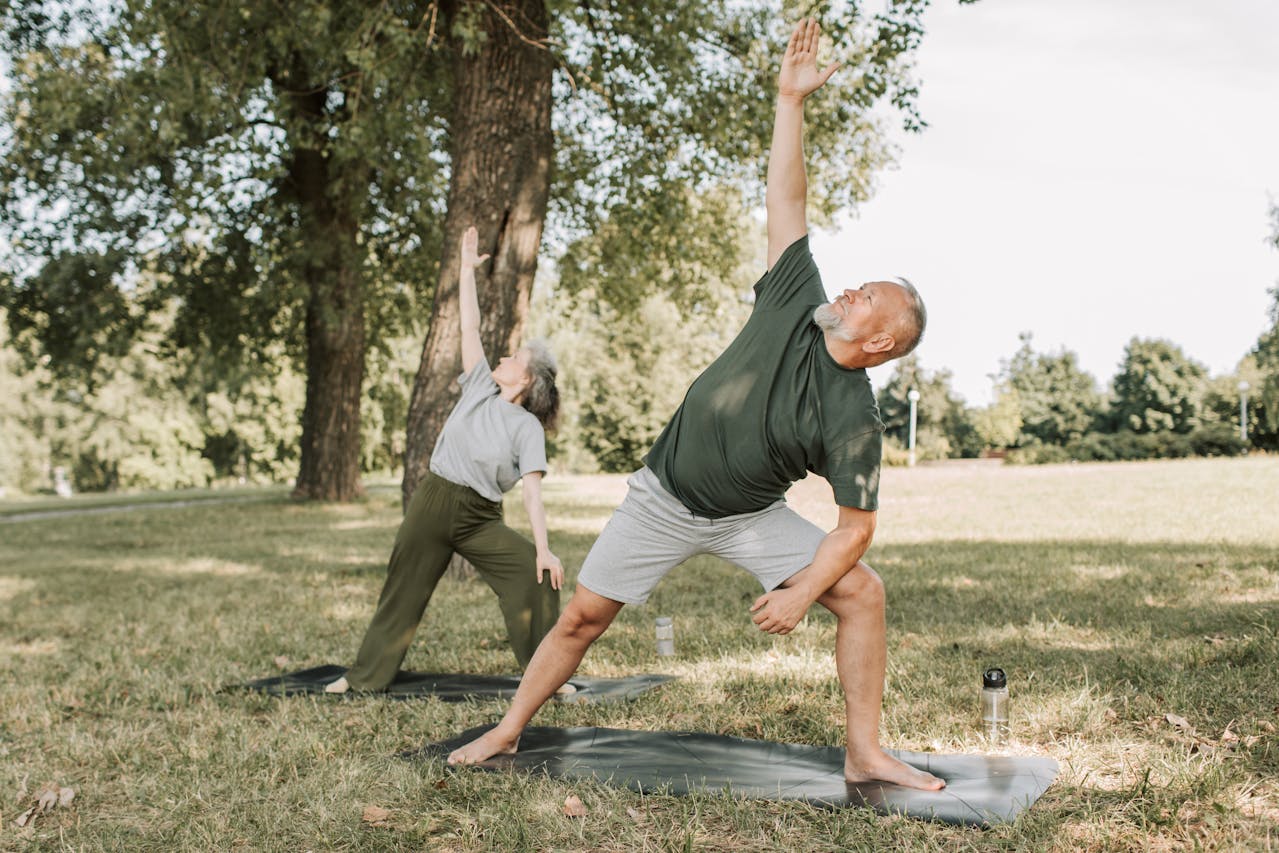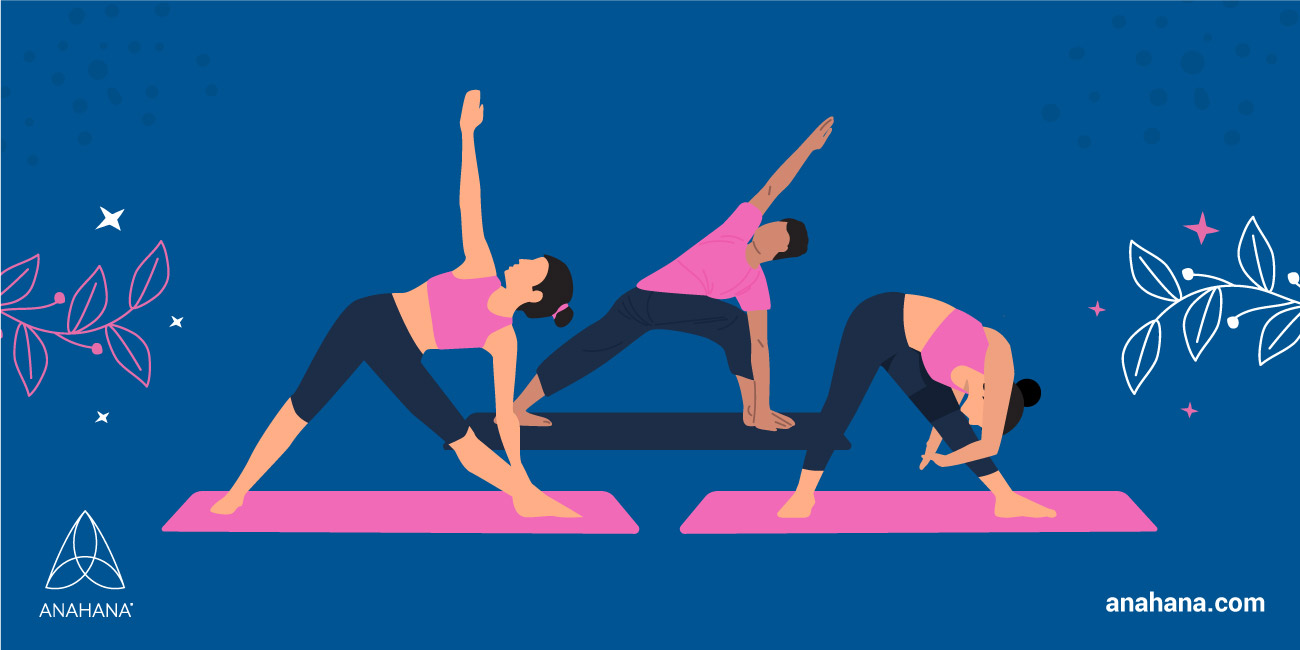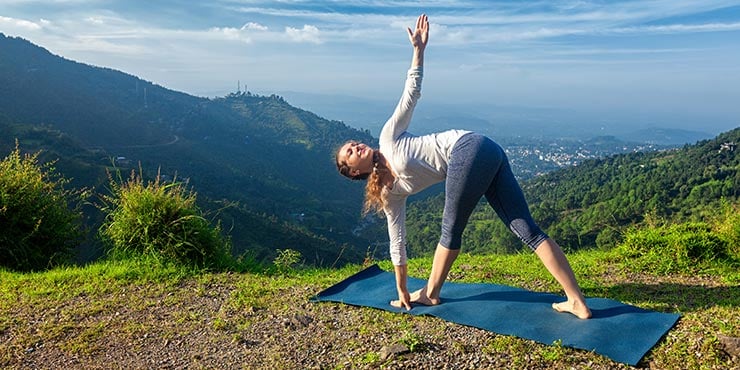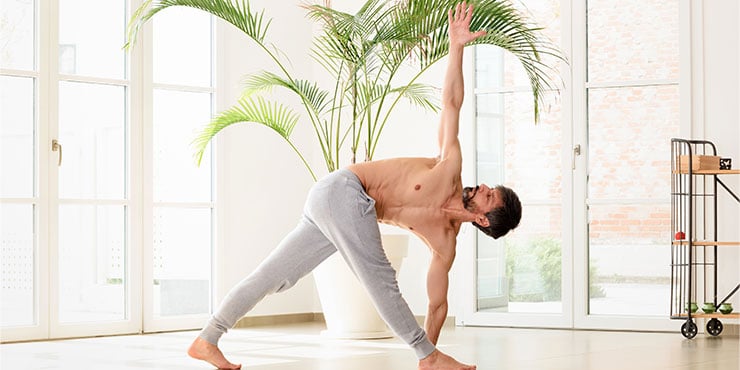
Table of Contents
Parivrtta Trikonasana, also known as Revolved Triangle Pose, is a twisting standing forward bend commonly incorporated in hatha yoga. This pose is known for improving balance, flexibility, and digestion.
Revolved Triangle Pose (Parivrtta Trikonasana)
 Parivrtta Trikonasana, commonly called Revolved Triangle Pose, is a yoga posture involving a deep twisting standing forward bend. To perform this asana, practitioners place one foot forward and one foot back while keeping both legs straight before turning the body towards the front leg.
Parivrtta Trikonasana, commonly called Revolved Triangle Pose, is a yoga posture involving a deep twisting standing forward bend. To perform this asana, practitioners place one foot forward and one foot back while keeping both legs straight before turning the body towards the front leg.
In the Ashtanga Yoga sequence, Parivrtta Trikonasana follows Utthita Trikonasana. The full expression of the pose involves placing the back hand outside the front foot, rotating the upper body towards the front leg, and directing the gaze upwards.
Sanskrit Meaning
The Sanskrit word "Parivrtta" translates to "to turn or revolve or twist," while "Trikona" means "triangle" and "Asana" means "posture or pose." Thus, Parivrtta Trikonasana is called Revolved Triangle Pose, Revolving Triangle, Twisting Triangle, or Reverse Triangle.
Revolved Triangle Pose Benefits
Some of the Parivrtta Trikonasana benefits include:
- Improves spinal flexibility: This intense side stretch pose supports chest opening, which helps enhance spinal flexibility and mobility.
- Increases balance and stability: Practicing this pose requires balance and stability, which can help improve overall balance and coordination.
- Strengthens legs and hips: The posture involves standing on one leg while twisting the torso, strengthening the legs and hips.
- Stimulates digestion: The twist stimulates the abdominal organs, aiding digestion and relieving digestive issues.
- Relieves lower back pain: The pose stretches the lower back muscles, which can help alleviate lower back pain and discomfort.
- Mental stability: Stimulates nervous system functions to help reduce stress and anxiety levels, promoting overall mental well-being.
Revolved Triangle Pose is associated with the Manipura Chakra, located in the solar plexus region of the body. The Manipura chakra influences personal power, confidence, and self-esteem, promoting feelings of empowerment and self-assurance.
Parivrtta Trikonasana Contraindictions
Revolved Triangle Pose (Parivrtta Trikonasana) is generally safe for most people to practice. Still, there are a few contraindications for practitioners to consider, including:
- Low blood pressure: As with most twisting poses, Revolved Triangle Pose may cause a temporary drop in blood pressure, which can be problematic for people with low blood pressure.
- Diarrhea: If you are experiencing diarrhea, it's best to avoid Revolved Triangle Pose, as it can aggravate the condition and cause discomfort.
- Spinal injuries: If you have a spinal injury or condition, it's best to avoid or modify this pose as it involves a deep twist that can strain the back.
- Neck injuries: Revolved Triangle Pose involves turning the head to look up towards the top hand, which can strain the neck.
- Pregnancy: Pregnant women should practice Revolved Triangle Pose with caution, avoiding deep twists that can put pressure on the abdomen.
When attending a regular class, the yoga teacher may advise students to avoid Reversed Triangle or other twisting poses when experiencing insomnia, headaches or migraines, or gastrointestinal distress. It is always essential to consult with a qualified yoga instructor or healthcare provider before attempting any new yoga pose, especially if one has any pre-existing medical conditions.
Step-By-Step Instructions to Practice Revolved Triangle Pose
 Here are the step-by-step instructions to practice Revolved Triangle Pose (Parivrtta Trikonasana):
Here are the step-by-step instructions to practice Revolved Triangle Pose (Parivrtta Trikonasana):
- Begin standing at the top of the mat in Mountain Pose, with the feet hip-distance apart.
- Step back with the left foot, turning it out at a 45-degree angle.
- Ensure the front foot points straight ahead, and the back foot is firmly grounded.
- Engage the quadriceps and lift the kneecaps to straighten both legs.
- Place the right hand on the hip and inhale as the left arm reaches up toward the ceiling.
- Take a deep breath and hinge forward from the hips, keeping the spine long.
- Place the left palm on the floor on the outside of the right foot or on a block while continuing to reach the right arm up towards the ceiling.
- Take a deep inhale, and as the exhale begins, twist the torso to the right, bringing the right shoulder towards the left thigh.
- Press the left hand into the ground or block to deepen the twist while also engaging the abdominal muscles to support the spine.
- If the practitioner feels stable, they can lift the left heel off the ground and straighten the left leg while maintaining the twist.
- Hold the pose for several breaths or up to one minute.
- To transition out of the pose, inhale and stand up, then step the left foot forward and exhale into Mountain Pose.
- Reverse the feet and repeat for the same length of time on the other side.
For beginners in Ashtanga yoga, forward bend can be used as a warm-up or preparation for the twist. Once ready, the twist can be added, with the bottom hand adjusted as needed. If the practitioner can't reach the floor with their hand, they can place it on their shin, a yoga block, or a chair for support.
Preparatory Poses for Parivrtta Trikonasana
To prepare for Revolved Triangle Pose, one can perform Pyramid Pose or Parsvottanasana, which involves bending forward with one leg in front and the other leg back. This helps to strengthen and stretch the hamstrings, preparing them for the stretch in Revolved Triangle Pose.
Another option for warming up is a simple standing twist, where the pelvis remains square while the ribcage twists to one side. Alternatively, one can turn the pelvis relative to the feet and then turn the ribcage relative to the pelvis. These twists help to familiarize the practitioner with the twisting element involved in Revolved Triangle Pose, making it easier to execute when the time comes.
Deepening Revolved Triangle Pose
To achieve the ideal position in Revolved Triangle Pose, one should begin by bending forward. Before twisting, the practitioner should side bend forward towards the front leg while maintaining the forward bend. This movement will bring the left shoulder over the right foot if the right leg is in front.
Once the side bend is complete, place the left hand on the floor outside the right foot. The practitioner can then begin the twist by lifting the right arm straight up while twisting the torso. This movement completes the pose, and the practitioner can hold it for several deep breaths or up to one minute.
Mastering the Art of Side Bending
To learn the technique of side bending, beginners can start practicing while standing or sitting, even in a chair. The first step is to tip the rib cage to one side while keeping both sitting bones on the chair. One should observe how the opposite side of the waist feels longer as they raise the opposite side of the rib cage from the top of the hip bone. Practitioners can then repeat this process on the other side.
Pay attention to the lengthening sensation on the stretched side and shortening on the contracted side. Once familiar with the feeling of the long side of the waist lengthening, one can learn to minimize the short side by deliberately contracting the opposite side of the waist using abdominal muscles to pull the rib cage towards the hip bone. Once mastered, they can try side bending while bending forward with feet parallel and hip-width apart in Uttanasana and using the foot position for Revolved Triangle pose.
Adjusting the Hips in Twisted Triangle Pose
In the Twisted Triangle pose, adjusting the hips' position can help relieve lower back pain. If the right leg is forward and the left leg is back, move the pelvis forward to lift the right hip and lower the left hip.
Moving the pelvis back will have the opposite effect, lowering the right hip and raising the left hip. One can also shift their pelvis right or left in relation to their feet to lift either hip higher. Experiment with rotating the pelvis slightly to the right or left to drop either hip. Adjusting the position of the pelvis can not only provide relief for the lower back but can also help one increase or decrease the intensity of the spinal twist.
Engaging The Hip Joint Muscles
 To activate the muscles of the hip joints, such as the glutes, while making hip adjustments in poses like Twisted Triangle, one can focus on engaging specific muscles.
To activate the muscles of the hip joints, such as the glutes, while making hip adjustments in poses like Twisted Triangle, one can focus on engaging specific muscles.
For instance, one can start by spreading their sitting bones or pulling them inward to activate the glutes. It is important to note that both actions may affect the pelvic floor muscles, so it's recommended to pay attention to how the entire body responds and adjust accordingly. By engaging the muscles of the hip joints, practitioners can create a more stable foundation for their poses and reduce the risk of injury.
Exerting the Pelvic Floor Muscles Against the Transverse Abdominis
Another method for activating the pelvic floor involves pulling inward and upward on the inguinal ligaments. These ligaments form the line that separates the belly from the inner thighs.
An individual can feel their pelvic floor engaging and lifting automatically by pulling up on the inguinal ligaments and inward on the ASIC. For a more profound activation, the movements of pulling upward and backward on the back surface of the sacrum, as if lifting the tailbone, can be combined. Although the movement is subtle, an individual should experience a sensation of muscular tension.
Sequential Poses for Twisting Triangle
When practicing the Ashtanga series and performing Twisting Triangle, follow up with Utthita Parsvokonasana (Side Angle) and then Parivrtta Parsvokonasana (Revolved Side Angle) to continue building strength and flexibility in the hips and legs.
For those looking to challenge their balance, Parivrtta Ardha Chandrasana (Revolved Half Moon Pose) is a similar pose to Parivrtta Trikonasana. In this pose, the back foot is lifted and reached straight back while the knee points down. Balancing on the front foot with support from the bottom hand can be difficult.
To transition from Revolved Triangle to Revolved Half Moon, shift the upper body forward so that the weight is over the front foot and lift the back foot while maintaining balance. This transition can be challenging, so focusing on the breathing pattern and engaging the core to maintain stability is essential.
Extended Triangle Pose
To transition from Parivrtta Trikonasana to Utthita Trikonasana, one can release the twist by returning the torso to a neutral position. The practitioner should then pivot on the back foot, ensuring it is parallel to the front foot.
Next, the front foot should be straight while keeping both feet grounded to create a stable foundation. The hips should be square toward the front of the mat, and the arms can extend to the sides, with the gaze directed towards the top hand.
Utthita Trikonasana, or Extended Triangle Pose, is an excellent posture for stretching and strengthening the legs, hips, and spine. It also helps to improve balance and concentration. To move back into Parivrtta Trikonasana, the practitioner can pivot back on the back heel and rotate the front torso towards the forward leg, placing the back hand on the floor outside the front foot and extending the top arm towards the ceiling.
References
https://www.yogajournal.com/poses/revolved-triangle-pose-2/
https://www.masterclass.com/articles/parivrtta-trikonasana-guide
https://en.wikipedia.org/wiki/Trikonasana
Disclaimer
The contents of this article are provided for informational purposes only and are not intended to substitute for professional medical advice, diagnosis, or treatment. It is always recommended to consult with a qualified healthcare provider before making any health-related changes or if you have any questions or concerns about your health. Anahana is not liable for any errors, omissions, or consequences that may occur from using the information provided.

By: Anahana
The Anahana team of researchers, writers, topic experts, and computer scientists come together worldwide to create educational and practical wellbeing articles, courses, and technology. Experienced professionals in mental and physical health, meditation, yoga, pilates, and many other fields collaborate to make complex topics easy to understand.
